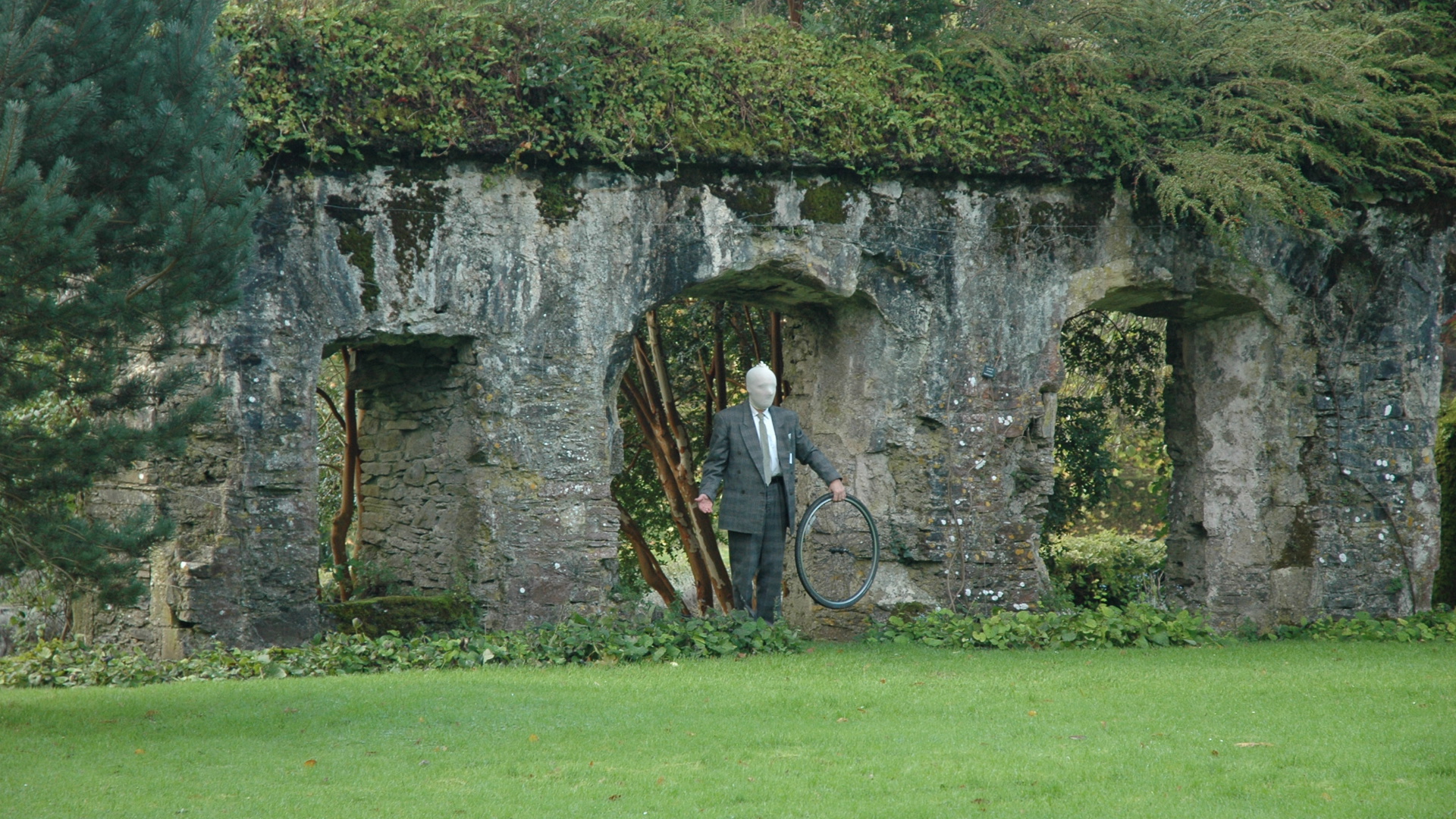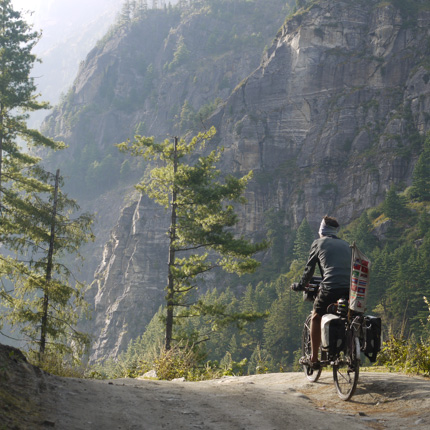
Phil Smith wears many hats. He is a playwright, performer, activist, researcher, writer and radical walker. His work uses walking, site-specific performance and mythogeography to encourage people to burrow beneath the official and the obvious. His most recent work includes The Pattern, “a handbook for exploration, embodiment and art making in strange times” produced in collaboration with artist Helen Billinghurst, and Bonelines, a “dark novel set in the 'Lovecraft Villages' of Devon” inspired by Phil and collaborator Tony Whitehead’s disparate discoveries during a series of ‘hyper-sensitised’ walks in the area. Our Editor Sam spoke with Phil about this work, its implications and whether he classifies it as adventure.
“Well, usually with great difficulty!” laughs Phil when I ask how he describes what he does. “I try to avoid that question if possible.”
Perhaps the best summary of his multi-disciplinary work is a desire to unearth “multiplicity of meaning” in places. “I try very much to work against the tendency that some institutions have, but also some practices have, which is to see certain places in a sort of homogenised way. So the heritage industry has a tendency to do this: its institutions tend to look for one story, or one dominant story, of a particular place, and then to simply embroider that story again and again.”
This homogenisation hides other possibilities. “Particularly in heritage spaces, the visitor or person in the space is really being addressed as a mind all the time,” Phil continues. “There is very little emphasis or invitation to engage sensually with those spaces. Very often there is not much invitation to engage imaginatively with those spaces.”
'I try very much to work against the tendency that some institutions have, but also some practices have, which is to see certain places in a sort of homogenised way.'

But Phil is doing battle less with institutions than with “ways of seeing.” He uses the example of how seeing the countryside through a “romantic bucolic” lens disguises certain features of rural landscapes, like the fact that luscious green fields are often that way not naturally, but thanks to the use of nitrogen.
Phil calls this multiplicity-seeking “mythogeography”. Whereas the better-known practice of psychogeography is concerned with the impact of (typically built) environments on psychology, mythogeography “certainly is interested in that, but it adds to that with the narratives of place.”
Narratives, to a mythogeographer, might be traditional myths, personal stories, historical accounts or even dreams. Any meaning layered into a place, objective or subjective, is worthy of curiosity. Mythogeography means an “approach to perception which is as much, or perhaps first driven by the anomalies rather than the regularities,” Phil explains. “It assumes odd and strange interpretations and meanings. If the evidence doesn't support those odd or strange meanings then you back off from them. But you don’t start with the official meaning … you can make extreme proposals.”
Phil references the Starbucks ‘mermaid’ logo, which is in fact a creature of medieval legend called Melusine - a woman with a serpentine bottom half. The Duke of Aquitaine, so the story goes, begged her hand in marriage. She agreed providing he didn’t interrupt her Saturday baths. Unable to resist, the Duke intruded, shocked at what he saw, causing Melusine to turn into a dragon and flee. Designed as a symbol of coffee’s seafaring history, the Starbucks ‘mermaid’ is in fact also a medieval portrayal of the multiplicity of female sexuality; by failing to allow Melusine a part of herself to herself, the Duke loses all of her.
'It assumes odd and strange interpretations and meanings. If the evidence doesn't support those odd or strange meanings then you back off from them. But you don’t start with the official meaning … you can make extreme proposals.'

Mythogeography underpins Phil’s related idea of “counter-tourism”. This idea here isn’t anti-tourism. “In counter-tourism,” Phil explains, “you’re not really doing anything that looks very different necessarily from an ordinary everyday tourist visit to a particular site. But within that conventional activity you can subvert the whole thing.”
In practice this means Phil is constantly looking to experience places in disruptive, creative, frankly unusual ways. He might take items like chalk, string or binoculars to engage with an environment as he goes. He has walked the same street every fortnight for two years, occasionally carrying red-and-white sticks and bags and wearing sardine badges to attract curiosity. And he recommends games designed to subvert ‘official’ viewing experiences of tourist sites, like trying to secretly collect as much dust as possible or trying to make eye contact with all statues in a heritage home.
The central tool in Phil’s toolkit, though, is walking. “It’s partly to do with its pace,” he says. Even a slow cycle feels too fast. “But it is also to do with its extraordinary flexibility. If you're driving along in a car and you suddenly spot something, you often can't just kind of swerve off the road and run back to it.”
But walking also opens the senses to an environment. This brings a vulnerability. “Putting your body at the mercy of the terrain: that is the key thing really. So you're not wrapped around with metal armour. If you step into a field full of bullocks that are a bit frisky, then you will feel the fear.”
'Putting your body at the mercy of the terrain: that is the key thing really. So you're not wrapped around with metal armour. If you step into a field full of bullocks that are a bit frisky, then you will feel the fear.'

Phil calls this type of walking - sensitive, creative, full of subversive potential - “hyper-sensitised” walking. Hyper-sensitised walking assumes “that a complex webbing is all around you,” and aims to tune into that webbing - to make one vulnerable to distraction and surprising turns of events. This, Phils says, is when “things start to happen.” He tells stories of stumbling across a tantric history in Italian gardens and 18th century prison cells beneath a hotel, and notes that even picking a deliberately banal suburb has led him to intriguing nooks with the right mindset.
Another distinction of hyper-sensitised walking, Phil says, “ would be that we probably wouldn't have a destination in mind. It wouldn’t be a walk to go anywhere in particular. And if we had a purpose, that purpose might not last very long.” One of his touchwords is MacGuffin: a device that sets a plot (or walk) in motion but really isn’t important in itself. Indeed, it is impossible not to be inspired by his endless capacity for curiosity and distraction.
But there is a serious, even radical potential to this curiosity. Phil sees hyper-sensitised walking as a valuable way to challenge certain contemporary tendencies, like what he calls “the war on subjectivity” being waged by algorithms seeking to predict our preferences before we even know them. Hyper-sensitised walking also allows us to “use our bodies to ground our thoughts in the terrain” and resist the idea that we inescapably rely on technology for information.

None of this should be mistaken as an egotistical attempt at self-expression. Phil’s pseudonym, Crab Man (which originated when people arriving for one of his performances, which involved a poster of Phil wearing a giant crab claw, began asking after the ‘crab man’) is in fact in part an attempt to remove his personality from his work. “It's not just removing your ego from it,” he explains. “It's also allowing other people a bit more into it. A lot of this stuff is not anything to do with a particular individual vision or anything. It's to do with involving lots of people in lots of vision.”
This is in contrast to the often personality-centric forms of adventure we see in adventure sports - a point Phil raises when I ask whether he sees his work as adventure. “I think it's really interesting how little that word comes up” in relation to his work, he reflects.
“It’s got some negative connotations in the sense of colonial adventures, military adventures,” he continues. He is also sceptical of “a sports take on walking or a sports take on journeying,” or adventure based around “thrill in a very disconnected way: leaping off a mountain on the end of a large piece of plastic, which creates enormous emotional and psychic rushes, but is often framed with very little attention being paid to the place that that's happening, or what the cultural significance of doing that thing is.”
'Thrill in a very disconnected way - leaping off a mountain on the end of a large piece of plastic - creates enormous emotional and psychic rushes, but is often framed with very little attention being paid to the place that that's happening, or what the cultural significance of doing that thing is.'

Having issued these caveats, Phil does acknowledge the adventure in what he does. Indeed, if one idea of adventure is as escape, either physically or through thrill, Phil’s work encourages a very different adventure - one concerned with going deeper and differently into places, and with cultivating an everyday mindset that sees places in peculiar but possibly transformative ways. It is difficult to think of a more worthwhile end.
Reading and recommendations
- The Mythogeography website has more information about mythogeography, Phil’s book of the same name and related concepts.
- His Counter Tourism website is also a useful resource.
- Phil’s Triarchy Press author page is a useful jumping-off point to his many books.
- Desire Paths, by Roy Bayfield, is a book about walks the author has undertaken, structured around mythogeographic ideas. Each chapter opens with a quote from Phil’s book Mythogeography.
- Ways of Making is the doctoral thesis of Helen Billinghurst, one of Phil’s collaborators. Based on a series of walks Helen took across England, it explores “the relationship between the activities of walking as art, and making in the studio.”







